Amazon road set to give Brazil and Peru new trade route
- Published
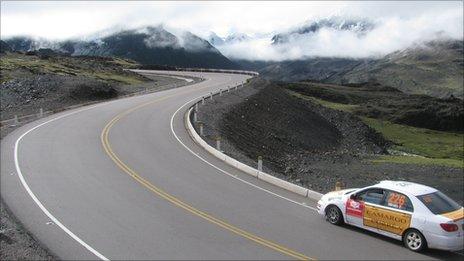
The road is making long isolated parts of Peru and Brazil more accessible
What better way to celebrate the opening of a road than by racing cars on it?
Around 30 Peruvian and Brazilian rally car drivers did exactly that to mark a new stretch of a road that connects their nations.
The two countries have historically had their figurative backs to one another with their shared border running through the Amazon rainforest, but are now trying to forge stronger links.
Setting off from Nazca, in Peru's coastal desert on 19 January, the drivers traversed the Andes cordillera to Cusco, rising to 4,725m (15,500ft) above sea level.
They then descended into the Amazon rainforest of Madre de Dios, the frontier region that borders Brazil and Bolivia.
Strategic location
The race over some 2,200km (1,367 miles) involved a brief break to cross a river by ferry as a key bridge is still not finished. Competitors then continued on to Inapari on the border, reached first by Peruvian professional rally car driver Nicolas Fuchs.
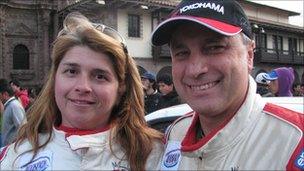
Luiz Facco and his wife, Cristina, were among those trying out the new route
Vehicle registration problems meant most of the drivers could not cross into Brazil to complete the last 200km or so to Rio Branco, capital of Acre state.
Bureaucratic problems aside, the dramatic route was the main challenge.
"The road doesn't just have curves, it has big drops, places where if you make a mistake, you die," said Luiz Facco, a Brazilian driver who raced alongside wife and co-driver Cristina, told the BBC in Cusco's main square.
Apart from being a symbol of South American integration, the road links will also boost - potentially hugely - trade with Asia.
China has already replaced the US as Brazil's number one trading partner. With this road, Brazil will eventually have paved access to five Pacific-facing Peruvian ports.
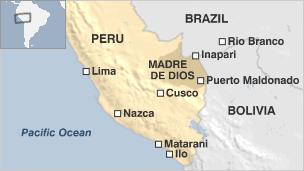
For its part, Peru is strategically sandwiched between two of the world's largest emerging economies - China to the west and Brazil, to the east.
"This road is a dream," says Miguel Vega, president of the Peru-Brazil Chamber of Commerce.
"As we say in football, the midfield dominates the game. This road will put Peru in the midfield between Asia and South America."
But the road is also proving to be an environmentalists' nightmare.
"Asphalting the road itself doesn't do any real harm," says Rob Williams, Peru research co-ordinator for the Frankfurt Zoological Society.
"It's the secondary roads which come off the main road in a fishbone pattern which do the damage. These continue to fragment the Amazon until the whole strip along the Interoceanic highway is deforested."
Gold rush
Widely viewed by scientists as the most bio-diverse corner of the Amazon rainforest, Madre de Dios is bisected by the road.
Where the Andes meet the Amazon, the Interoceanic highway passes directly through the town of Quince Mil. In its main square is a statue of an old man panning for gold.
"Everyone knows how to pan for gold here but nowadays miners are coming with heavy machinery and mercury," says Quince Mil resident Ozwaldo Escobar.
"They are polluting our water supply, killing the fish and destroying the forest.
"There's little we can do because they bribe the police and the local authorities," he alleges.
A young man, known just as Renzo, told the BBC he gets weekly visits from his Lima-based gold buyer, who pays 108 Peruvian soles ($38.97) per gram for the precious metal.
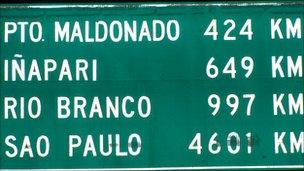
Journeys that lasted days are now taking hours
Driving eastward deeper into the Amazon lowlands, a sea of blue tarpaulin springs up from the roadside. It is a tent city but it is bustling with commerce.
Food and other supplies are sold out of the back of passing lorries and motorcycle workshops do a roaring trade amid the constant thrum of petrol-fuelled generators.
Some of these gold rush settlements are so new they are known simply as kilometre 108 and 115, marking their distance from Cusco.
From the edge of the road they cut into the jungle, spreading out into dozens of routes to gold mines. Seen from the air whole patches of rainforest are pocked by stagnant mercury-polluted pools or turned into desert.
At junctures along the highway, government placards show pictures of how awful the road once was and how it looks now, with messages like: Before: Devastation; Now: Optimism.
Triumph or disaster?
But the road is not only set to boost trade, but also migration.
More than 200 people a day are coming from the Andes to the Amazon, swelling an estimated 30,000 people living from illicit gold mining, says Juan Carlos Navarro of Caritas, a Roman Catholic charity based in Puerto Maldonado, the regional capital of Madre de Dios.
"The government institutions are simply too weak to control it," said Mr Navarro. The local authorities were petitioning the central government to declare an environmental state of emergency in the region, he added.
"More than development, the road has brought us problems," says Luis Aguirre, just a month into his new job as governor of Madre de Dios.
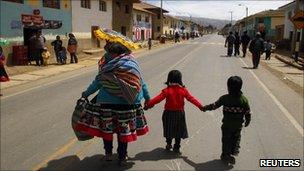
Will the roads bring about a big population shift?
"It was supposed to bring progress but instead it's brought us more crime, more drug-addiction, more deforestation, more ecological destruction and more unchecked migration."
It seems a pessimistic assessment at odds with the triumphant tone of Peruvian President Alan Garcia. He has called the five years spent building the 2,589km-long road as man's triumph over nature and distance.
On its final leg, the rally car race speeds through the sleepy border town of Inapari where excited boys and their fathers line the road, mobile phone cameras poised to snap a picture.
Suleyde Ochoa left Inapari 23 years ago. Now married to an Iranian and with two daughters, she has returned to set up a roadside restaurant.
"Before the road was so bad it would take a week just to get to Puerto Maldonado," she told the BBC. The journey now takes no more than three hours.
"I see a real future here now, that's why I've come back with my family".